GENESIS 950 INSTRUCTIONS
When using Genesis 950, understanding how it works will help you choose how to use it for various cleaning needs. Genesis 950 is a surfactant based cleaner. As a surfactant, Genesis 950 needs water to activate it. Working together, Genesis 950 allows a stain to become permeable. Once permeable, water and Genesis 95o make the stain porous and can then work to break down the bonds of the stain. When a stain’s bonds are broken, it can then be flushed clean from the surface. Genesis 950 can clean the toughest stains from food and drinks to pet stains and odors, as well as makeup, paint, oil, grease and countless other things.
SPOT CLEANING — HOW MUCH GENESIS 950 SHOULD I USE?
GENERAL CLEANING WITH GENESIS 950
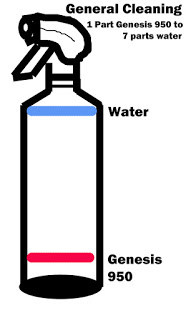
To use Genesis 950 as a general cleaner, it can be diluted with water at a ratio of 1 part Genesis 950 to 7 parts water. Simply spray the stained area and allow the mixture to sit for a few moments to dissolve the stains. After a few minutes, wipe the area clean.
GENERAL CLEANING
- Kitchen & Bathroom Counters
- Marble, Stone & Granite
- Tile, Laminate, Hardwood Floors
- Sinks, Tubs & Showers
- Stainless Steel Appliances
- Wall, Doors & Molding
- Cars, Cycles, Boats & RVs
HEAVY CLEANING WITH GENESIS 950
 When the stains are heavier, or more substantial in the composition, increase the amount of Genesis 950 by filling a spray bottle up 1/3 of the way with Genesis 950 and the remaining 2/3 with water. Spray the stains with the mixture ensuring the stained area is heavily saturated. With heavier stains, the mixture should also be given more time to soak into the stain. Allow the mixture to soak the stain for anywhere from 5 to 20 minutes. After enough time has elapsed, wipe the stain up. If the stain is really heavy (paint, makeup, etc.), you may have to repeat the step, or work at lifting the edges of the stain to allow the mixture to seep under the stain as well as over it. In the event the stain has lightened, and not completely removed, allow the stain to dry completely. Once dry, repeat the process.
When the stains are heavier, or more substantial in the composition, increase the amount of Genesis 950 by filling a spray bottle up 1/3 of the way with Genesis 950 and the remaining 2/3 with water. Spray the stains with the mixture ensuring the stained area is heavily saturated. With heavier stains, the mixture should also be given more time to soak into the stain. Allow the mixture to soak the stain for anywhere from 5 to 20 minutes. After enough time has elapsed, wipe the stain up. If the stain is really heavy (paint, makeup, etc.), you may have to repeat the step, or work at lifting the edges of the stain to allow the mixture to seep under the stain as well as over it. In the event the stain has lightened, and not completely removed, allow the stain to dry completely. Once dry, repeat the process.
HEAVY CLEANING
- Pet Stains
- Food & Drink Spills
- Food & Grease Buildup On Appliances
- Stove Tops
- Inside Refrigerators & Freezers
- Concrete Stains
- Paint, Ink & Makeup Stains
EXTREME CLEANING WITH GENESIS 950
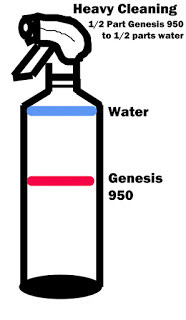 In extreme cases, the ratio of Genesis 950 can be increased to a 50/50 mix with water. Use this option as a last resort only. Use this option only in the event that previous mixtures have not been effective. Typically, we advise people not to use this ratio because we want the product to last for you. We do not want people using a whole bottle of Genesis 950 on a stain that could have been removed with a lower ratio. Use this mix for really bad pet stains, extremely heavy build up or older stains. Prior to attempting to use a 50/50 mix, you can also pour a little Genesis 950 straight onto a stain AFTER you have tried removing the stain at a lower ratio. If for example you treated a stain as directed in the Heavy Cleaning procedure, and the stain is on the brink of being removed through that process, pour just a few drops straight onto the already wet stain and work the mixture into the already saturated stain with a towel or rag. Use this method sparingly.
In extreme cases, the ratio of Genesis 950 can be increased to a 50/50 mix with water. Use this option as a last resort only. Use this option only in the event that previous mixtures have not been effective. Typically, we advise people not to use this ratio because we want the product to last for you. We do not want people using a whole bottle of Genesis 950 on a stain that could have been removed with a lower ratio. Use this mix for really bad pet stains, extremely heavy build up or older stains. Prior to attempting to use a 50/50 mix, you can also pour a little Genesis 950 straight onto a stain AFTER you have tried removing the stain at a lower ratio. If for example you treated a stain as directed in the Heavy Cleaning procedure, and the stain is on the brink of being removed through that process, pour just a few drops straight onto the already wet stain and work the mixture into the already saturated stain with a towel or rag. Use this method sparingly.
EXTREME CLEANING
- Heavy or Old Pet Stains
- Large Food & Drink Spills
- Dried Food & Grease Buildup On Appliances
- Inside Ovens
- Concrete Stains
- Heavy Paint, Ink & Makeup Stains
- Engine Degreasing
- Car Detailing
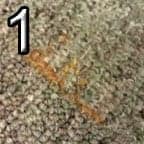
To remove stains using Genesis 950 as a spot cleaner, first locate the stain. In this example, a rust stain on carpet from a metal file cabinet is used.

Spray the stain with a mixture of Genesis 950 & water. In this example with mixture used is 1/3 Genesis 950 to 2/3 water. Thoroughly saturate the area with the mixture and allow it to sit for a few moments.
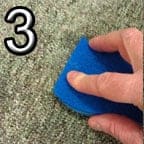
After the mixture has set into the stain, use a damp cloth or sponge to wipe down the area. The stain should break down easily. Pull up the debris from the stain with the cloth or sponge.
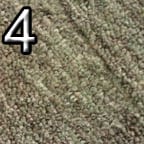
Once the stain has been removed, allow the area to dry. In the event any outlines of the stain still exist, try to rinse the area more, or allow to dry and repeat the process once the area is dry.
